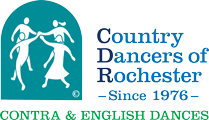
How does the open band work at CDR Community Dances?
Clara Riedlinger & Micah Wiesner – playing fiddle and guitar – lead the group through relatively simple tunes at a moderate tempo for dancers led by a caller. The tunes are played by ear, no sheet music or charts. Generally, we will play in one key (usually D, G, or A) for a few tunes before switching.
Anyone can join! Any level of playing ability is welcome, though you should be able to play in time to the beat, even if you make a few mistakes. Further info to help you assess your playing level is below. Instrumentation usually includes fiddle, guitar, banjo, and upright bass, and may also include other string instruments, accordion, flute or pipes, foot percussion, drums and other acoustic instruments.
Just show up at 5:45! Have a look at the tune list and try to listen to a few of the tunes before you come. We will not be teaching any specific tunes and no one is expected to know every tune we play. The idea is to practice listening and playing by ear and to make the group sound cohesive and rhythmic. No one is expected to be perfect!
Generally, fiddle players will lead tunes. Clara will lead most of them, but other strong fiddlers should feel welcome to make suggestions and lead tunes as well. We will play each tune for as long as the caller tells us to, usually about 7 minutes at around 110-120 bpm depending on the dance. Each tune should be square, AABB form. Tunes will generally be from the American “old time” tradition, but Irish, Québècois, and other similar traditions are also welcome. The forms will be mostly reels (4/4 time), some jigs (6/8 time), and some waltzes (3/4).
Beginner? Intermediate? Advanced?
Not sure what level you are? Advanced player who’s never played for a dance or by ear? Total Beginner? Never played with other people? Here are some skills you should have to help you assess your playing ability in this context.
Fiddle
Beginner:
- You can play whole notes or shuffles in time to the rhythm, even if you don’t play every note of the melody.
- You have 2-3 simple tunes that you can play comfortably “at speed”, even if you need additional support.
Intermediate:
- You’re comfortable picking up most tunes by ear, even if you don’t get every note.
- You have 5-10 tunes that you can lead comfortably at speed, with solid rhythm, clear tone, and at a volume that others can easily hear and follow.
- You can read guitar chord shapes from a rhythm player’s hand.
Advanced:
- You’re comfortable playing any tune by ear, and may even add harmony lines.
- You have dozens of tunes you can comfortably lead with clear rhythm and tone
- You can walk people through the chords, and/or let rhythm players know if there’s anything outside of the expected chord structure
Guitar/Rhythm
Beginner:
- You know how to “Boom-Chuck” in time with the beat, using a flat pick (or your fingers if you’re playing upright bass)
- You know your 1-4-6 chord shapes in the keys of A, D, G, and C and can switch comfortably between them in time with the beat
- You may not know how to hear chord changes, but you can look at others hands and follow along
Intermediate:
- You know your 1-4-5-6-2 chords in each key and can switch comfortably between them at speed
- You can play a few bass runs between chords
- You can hear most chord changes
- You can read other players’ hands, even if they’re using a capo
Advanced:
- You can clearly hear chord changes based on the fiddle melody, but know to check in with other guitar, banjo, and bass players.
- You can comfortably play bass runs between chords in each key
- You may be able to flatpick some fiddle melodies (not required!)
- You know when to hold back and do less for the good of the group!
Other More Useful Tools for Rhythm Players (everyone):
The Nashville Number System & Missouri Rules
Often, chords will be given in number form. You may hear someone say “This tune goes 1-1-4-1-1-4-5-1” or “Play the minor 2” What does that mean??? It’s the easiest way to communicate chord structure in any key, even if some people are using capos and other aren’t. The chord sound will remain consistent, even if the shapes are different.
Each scale degree is assigned a number starting with the root as 1.
Ex: In the key of A, A=1, B=2, C=3, D=4, E=5, F=6, G=7
In the key of G, G=1, A=2, B=3, C=4, D=5, E=6, F=7
It’s worth memorizing the 1-4-5-6m-2m shapes in the most common keys. It’s also worth memorizing the very common “Missouri Rules” chord structure: 1-1-1-5 1-4-5-1
